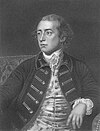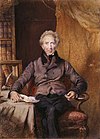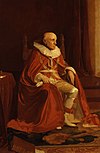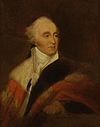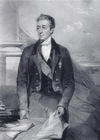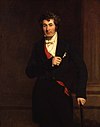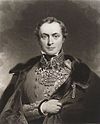
The Governor-General of India was the representative of the monarch of the United Kingdom and after Indian independence in 1947, the representative of the Indian head of state. The office was created in 1773, with the title of ‘Governor-general of the Presidency of Fort William’. The officer had direct control only over Fort William, but supervised other East India Company officials in India. Complete authority over all of British India was granted in 1833, and the official came to be known as the "governor-general of India".

Mirza Muhammad Siraj-ud-Daulah, commonly known as Siraj-ud-Daulah, was the last independent Nawab of Bengal. The end of his reign marked the start of British East India Company rule over Bengal and later almost entire South Asia.

The Bengal Presidency, officially the Presidency of Fort William and later Bengal Province, was a subdivision of the British Empire in India. At the height of its territorial jurisdiction, it covered large parts of what is now South Asia and Southeast Asia. Bengal proper covered the ethno-linguistic region of Bengal. Calcutta, the city which grew around Fort William, was the capital of the Bengal Presidency. For many years, the Governor of Bengal was concurrently the Viceroy of India and Calcutta was the de facto capital of India until the early 20th-century.

Abul Kasem Fazlul Huq popularly known as Sher-e-Bangla, was a Bengali statesman and jurist who served as the first Prime Minister of Bengal and later as the Home Minister of Pakistan. A key figure in Pakistan Movement, widely remembered for presenting Pakistan Resolution, he played major political roles in British India and later in Pakistan and held various other political offices.

The Nawab of Bengal was the hereditary ruler of Bengal Subah in Mughal India. In the early 18th-century, the Nawabs were de facto independent rulers of Mughal-era districts in Bengal, Bihar, and Orissa. They are often referred to as the Nawab of Bengal, Bihar and Orissa. Their territory included modern eastern India and Bangladesh. After 1880, the title was known as the Nawab of Murshidabad in British India.

Syed Mir Jafar Ali Khan Bahadur was a military general who became the first dependent Nawab of Bengal of the British East India Company. His reign has been considered to be the start of British imperialism in Indian history and a key step in the eventual British domination of vast areas of the Indian subcontinent.

The Provinces of India, earlier Presidencies of British India and still earlier, Presidency towns, were the administrative divisions of British governance in India. Collectively, they were called British India. In one form or another, they existed between 1612 and 1947, conventionally divided into three historical periods:

The Bangabhaban is the official residence and principal workplace of the President of Bangladesh, located on Bangabhaban Road, and short road connecting Dilkusha Avenue, Dhaka. It is surrounded by the Bangabhaban Gardens.

Nawab Sir Khwaja Salimullah Bahadur was the fourth Nawab of Dhaka and one of the leading Muslim politicians during the British Raj. In 1906, the Muslim League was officially founded at the educational conference held in Dhaka. The convention was held at Ahsan Manzil, the official residence of the Dhaka Nawab Family. Sir Salimullah was a key patron of education for the Eastern Bengal. He was one of the founders of the University of Dhaka and the prestigious Ahsanullah School of Engineering. Sir Salimullah was a staunch supporter of the Partition of Bengal and was a member of East Bengal and Assam Legislative Council from 1906 to 1907. He was also a member of Bengal Legislative Assembly from 1913 till his death in Calcutta in 1915 at the age of 43. He was the founder President of Bengal Muslim League in 1907.

The Nawab of Dhaka was the largest Muslim zamindar in British Bengal and Assam, based in Dhaka. The title of nawab, similar to the British peerage, was conferred upon the head of the family by the British Raj as a recognition of their loyalty and contribution to the social welfare activities.
The Singranatore family is the consanguineous name given to a noble family in Rajshahi of landed aristocracy in erstwhile East Bengal that were prominent in the nineteenth century till the fall of the monarchy in India by Royal Assent in 1947 and subsequently abolished by the newly formed democratic Government of East Pakistan in 1950 by the State Acquisition Act.

Najm ud-din Ali Khan, better known as Najm-ud-Daulah, was the Nawab of Bengal, Bihar and Orissa from 1765 to 1766. He was the second son of Mir Jafar.
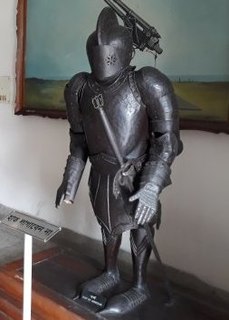
Bangladesh's military history is intertwined with the history of a larger region, including present-day India, Pakistan, Nepal, Bhutan and Myanmar. The country was historically part of Bengal– a major medieval power in South Asia and Southeast Asia.

The East Bengal State Acquisition and Tenancy Act of 1950 was a law passed by the newly formed democratic Government of East Bengal in the Dominion of Pakistan. The bill was drafted on 31 March 1948 during the early years of Pakistan and passed on 16 May 1951. Before passage of the legislature, landed revenue laws of Bengal consisted of the Permanent Settlement Regulations of 1793 and the Bengal Tenancy Act of 1885.

The Zamindars of Bengal were influential in administration, in the Bengal region, in the eastern part of the Indian subcontinent, which consists of territories East Bengal which is now Bangladesh and West Bengal. The Nawabs of Bengal ruled the area under the Mughal Empire from 1717 to 1880. Murshid Quli Jafar Khan governed the area, through his feudal chiefs, the zamindars, which mirrored the European system of serfdom. The zamindars dominated most of the villages in Bengal.

Zamindars of Natore were influential aristocratic Bengali Zamindars, who owned large estates in what is today Natore District in Bangladesh.
The Sylhet referendum was a referendum held in Sylhet to decide whether Sylhet would remain in Assam and join the new country of India or would join the province of East Bengal and the new country of Pakistan. The referendum decided in favor of joining Pakistan; however, Karimganj remained in India.
The Bengal Provincial Muslim League (BPML) was the branch of the All India Muslim League in the British Indian province of Bengal. It was established in Dacca on 2 March 1912. Its official language was Bengali. The party played an important role in the Bengal Legislative Council and in the Bengal Legislative Assembly, where two of the Prime Ministers of Bengal were from the party. It was vital to the creation of the Dominion of Pakistan, particularly after its election victory in 1946.
